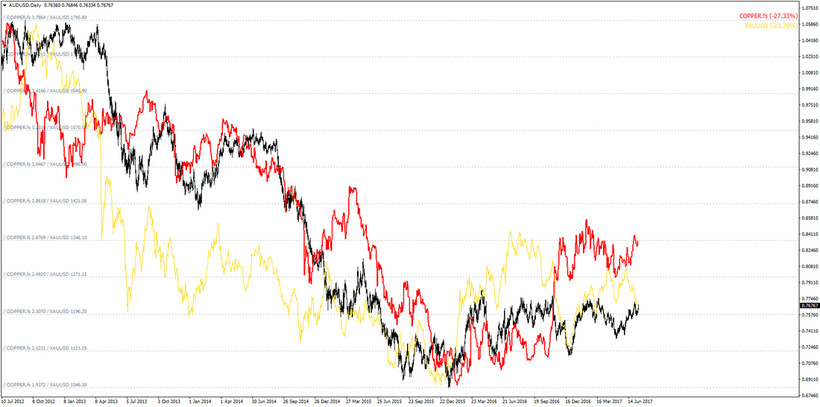No market lives in isolation in the real world. Whether it’s FOREX, stocks, commodities or any other financial market, at least some level of correlation always exists between the different markets.
Consider a simple example of an electronics market here. A local economy, trends of savings, technological advancements, and interest rates are likely to impact sales and purchases in this market.
Similarly, we cannot expect the global FOREX market to exist in isolation without getting affected by numerous other variables.
While it is practically impossible to follow and take into account every single factor affecting currency exchange rates, it is possible to consider the inter-relationships between crucially related markets.
For example, a change in supply or demand of commodities, such as oil or gold can directly influence some FOREX pairs and their exchange rates.
Similarly, bond rates, interest rates, and stock prices can also increase or decrease the demand for a currency and hence the exchange rates of affected currency pairs. It is, therefore, imperative for professional FOREX traders to keep inter-market correlation in mind when deciding to buy or sell any currency pair.
Inter-Market Analysis of Commodities and Currencies
Let’s start with the analysis of the relationships between commodities and some of the major currencies.
Australia is one of the world’s largest producers and exporters of metals, including gold. An increase in metal prices or an increase in global demand for metals will also subsequently increase the value of the Australian Dollar (AUD).
Being its neighbor, New Zealand’s economy also usually moves along in the direction of the Australian economy. Hence, the impact on New Zealand Dollar (NZD) is likely to be similar to that of the Australian Dollar.
On the other hand, Japan is known as a large importer of commodities and metals. An increase in commodity prices is likely to negatively impact the Japanese Yen (JPY).

The Australian Dollar has a strong correlation with Gold and Copper prices
Canada is one of the biggest exporters of oil. An increase in oil prices will be positive for its economy and its currency – the Canadian Dollar (CAD). In contrast, an increase in oil or gold prices will often be accompanied by a depreciation of the US Dollar (USD). Similarly, an increase in global interest rates is also considered to be good for AUD and CAD.
A small glimpse into intermarket analysis of the FOREX market has been provided in the above paragraphs. Though it is just an introduction to the topic and a lot more can be said, it still demonstrates the importance of intermarket analysis when trading FOREX. More importantly, each such trend is backed by data and logic.
Why there is a Correlation
Understanding the underlying factors which result in the establishment of positive or negative correlation between FOREX and other markets is essential for ensuring solid analysis.
For example, the Australian Dollar (AUD) and the Swiss Franc (CHF) often move together with gold prices because Australia is one of the top gold producers in the world and Switzerland has more than 25% of its reserves backed by gold. Similarly, a decrease in metal prices can result in an appreciation of the Japanese Yen since fewer Yens will be required to import the same amount of metals.
Carry Trade Strategy
The concept of the carry trade has been discussed in greater detail in an earlier article .
The strategy of carry trading basically depends on the difference in interest rates (or bond yields) between two countries (currencies).
Actually, bond spreads (the difference between bond yields of two countries) can also be used to predict currency movements. Remember that a bond yield simply represents the rate of return for a given bond.
If the bond yields difference increases between two countries, the currency having higher bond yields will experience an appreciation in its value against the currency with lower yields. Similarly, higher returns on fixed income securities also result in an increase in the value of the domestic currency.
Stocks and Currencies
Movements in stock markets can have a significant influence on currency rates as well. Some currency pairs respond more aggressively to stock market fluctuations than others. For example, it has been observed that a fall in the Japanese Nikkei stock index often results in a decline of the USD/JPY currency pair. In other words, investors favor holding Japanese Yen (JPY) over stocks in times of economic crisis in Japan.
Risk Appetite of Investors
Moreover, risk appetite of investors also plays a vital role in determining currency movements in the short term. If investors are generally willing to take risks, they prefer to invest in stocks.
This often leads to a rise in the value of pairs like NZD/USD, AUD/USD and EUR/JPY and fall in pairs like EUR/AUD and USD/CAD. The opposite is true in a situation when investors are generally afraid to take risks. FOREX pairs like NZDUSD, AUDUSD, and EURJPY usually experience sharp declines during such times.
The fact of the matter is that understanding the correlation between equity markets and currency movements can be very tricky. It can be dependent on investors risk appetite among other factors and hence, care must be taken when making decisions based on past data.
Summary
This article has discussed how different and apparently unrelated markets can impact the FOREX market among a number of other factors. It is strongly recommended to consider intermarket analysis in order to ensure long-term success in the FOREX market.
Although nothing works perfectly in trading, correlations more often than not drive exchange rates in an orderly and fairly predictable manner. Deriving trading signals from a single source is not the best practice and should be avoided. Using intermarket analysis ensures that the trader considers the most important fundamental driving factors for any given currency pair.





